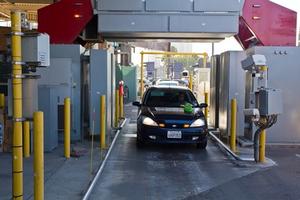Border securityCBP takes another stab at high-tech border security
The George W. Bush administration’s effort to build a high-tech border security system – the Boeing-led SBINet – was a failure, and the Obama administration shut it down in 2011. CBP is now trying again, this time with Elbit Systems as the lead contractor. The hope is that the lessons of the doomed SBINet, and Elbit’s experience in building high-tech defensive systems along Israel’s borders, would yield better result this time around.

Car passes through high-tech scanners at San Ysidro crossing // Source: cbp.gov
Mark Borkowski, assistant commissioner for the Office of Technology Innovation and Acquisition at CBP, described during a recent March 2014 hearing at the House Homeland Security Subcommittee on Border and Maritime Security the agency’s plan to introduce a high-tech virtual fence along the Arizona-Mexico border. Fifty fixed towers equipped with cameras, radars, and sensors would detect illegal activities miles away as part of the Arizona Border Surveillance Technology Plan. The project will use ground sensors and handheld thermal imaging devices that provide agents with night vision.
Israeli company Elbit Systems has been awarded the contract for the project, estimated to cost between $500 million and $700 million over ten years. Elbit is familiar with border protection through its work with the Israeli military to help secure Israel’s air, sea, and land entry points, and this experience made it an attractive candidate for the CBP plan.
TheChristian Science Monitor has reports that as the plan moves forward, some legislators are comparing it to a similar project under President George W. Bush, in which DHS awarded Boeing a contract to build a high-tech virtual fence along the United States-Mexico border. The Obama administration shut the project down in 2011 after it covered just fifty-three miles and had cost $1 billion. That program, SBInet, had design and mechanical flaws, including equipment malfunctions due to intense heat.
The Government Accountability Office (GAO) recently released a report cautioning the CBP that it should provide oversight and expand testing of the fixed surveillance towers to prevent failures similar to those of of SBInet. Elbit Systems, a Boeing subcontractor for SBInet, believes that the current CBP plan will be successful because the concept has been implemented and tested in Israel, then tailored to distinct parts of the Arizona-Mexico border, whereas SBInet was a one-size-fit-all approach using new technology.
Christopher Bronk, an information technology fellow at Rice University, attributed the failure of SBInet in part to its complexity. “It was a big, heavy, intelligence solution that was probably too ambitious for the mission and ended up becoming pretty expensive,” he said. Bronk sys that the new plan, with solid performance measurements and effective management, has a positive chance for success.
“Is it really necessary, is it going to be effective, is it going to return on the taxpayers’ investment? These are all legitimate questions,” said Steve Ellis vice president of Taxpayers of Common Sense. Acknowledging skeptics of the new plan, Borkowski agreed that CBP needed to collect better data on how the plan will help capture illegal border-crossers and drug smugglers. For now, the system will track and record illegal border crossings and notify computers at a command center, thereby dispatching agents to identified locations.
To date, the project is behind schedule, and the flow of illegal border crossings has been shifting from Arizona to Texas. The Monitor reported that the border patrol’s Tucson division recorded the highest count of arrests along the southern border in nearly two decades, but in fiscal year 2013 it counted 33,514 fewer than the Rio Grande division which recorded 154,453 arrests.
